硬核!8个类手写一个配置中心!
Posted Java知音_
tags:
篇首语:本文由小常识网(cha138.com)小编为大家整理,主要介绍了硬核!8个类手写一个配置中心!相关的知识,希望对你有一定的参考价值。
配置中心是我们平常使用微服务架构时重要的一个模块,常用的配置中心组件也比较多,从早期的Spring Cloud Config,到Disconf、Apollo、Nacos等,它们支持的功能、产品的性能以及给用户的体验也各有不同。
虽然说功能上有不少差异,但是它们解决的最核心问题,无疑是配置文件修改后的实时生效,有时候在搬砖之余Hydra就在好奇实时生效是如何实现的、如果让我来设计又会怎么去实现,于是这几天抽出了点空闲时间,摸鱼摸出了个简易版的单机配置中心,先来看看效果:

之所以说是简易版本,首先是因为实现的核心功能就只有配置修改后实时生效,并且代码的实现也非常简单,一共只用了8个类就实现了这个核心功能,看一下代码的结构,核心类就是core包中的这8个类:
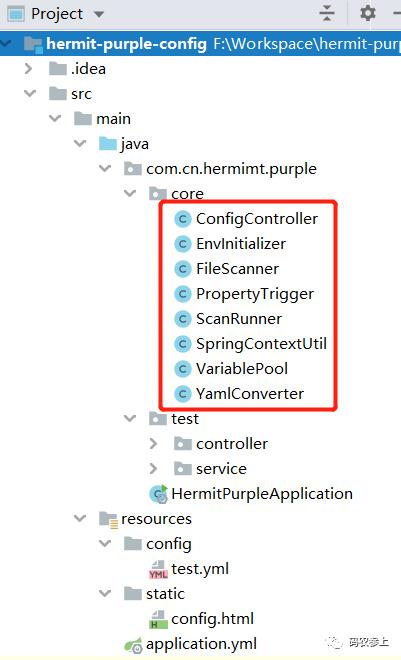
看到这是不是有点好奇,虽说是低配版,就凭这么几个类也能实现一个配置中心?那么先看一下总体的设计流程,下面我们再细说代码。
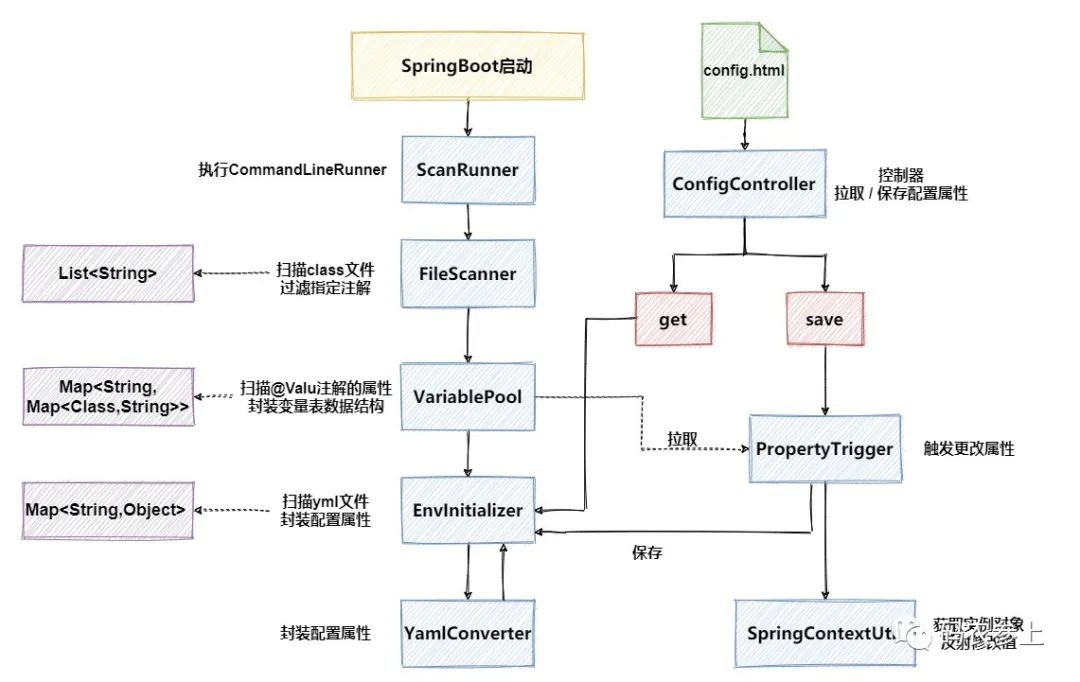
代码简要说明
下面对8个核心类进行一下简要说明并贴出核心代码,有的类中代码比较长,可能对手机浏览的小伙伴不是非常友好,建议收藏后以后电脑浏览器打开(骗波收藏,计划通!)。另外Hydra已经把项目的全部代码上传到了git,有需要的小伙伴可以移步文末获取地址。
1、ScanRunner
ScanRunner实现了CommandLineRunner接口,可以保证它在springboot启动最后执行,这样就能确保其他的Bean已经实例化结束并被放入了容器中。至于为什么起名叫ScanRunner,是因为这里要实现的主要就是扫描类相关功能。先看一下代码:
@Component
public class ScanRunner implements CommandLineRunner
@Override
public void run(String... args) throws Exception
doScanComponent();
private void doScanComponent()
String rootPath = this.getClass().getResource("/").getPath();
List<String> fileList = FileScanner.findFileByType(rootPath,null,FileScanner.TYPE_CLASS);
doFilter(rootPath,fileList);
EnvInitializer.init();
private void doFilter(String rootPath, List<String> fileList)
rootPath = FileScanner.getRealRootPath(rootPath);
for (String fullPath : fileList)
String shortName = fullPath.replace(rootPath, "")
.replace(FileScanner.TYPE_CLASS,"");
String packageFileName=shortName.replaceAll(Matcher.quoteReplacement(File.separator),"\\\\.");
try
Class clazz = Class.forName(packageFileName);
if (clazz.isAnnotationPresent(Component.class)
|| clazz.isAnnotationPresent(Controller.class)
||clazz.isAnnotationPresent(Service.class))
VariablePool.add(clazz);
catch (ClassNotFoundException e)
e.printStackTrace();
真正实现文件扫描功能是调用的FileScanner,它的实现我们后面具体再说,在功能上它能够根据文件后缀名扫描某一目录下的全部文件,这里首先扫描出了target目录下全部以.class结尾的文件:
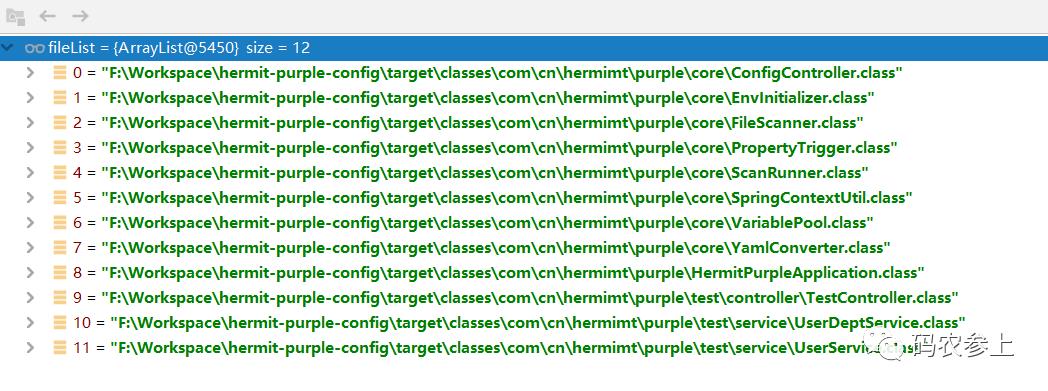
扫描到全部class文件后,就可以利用类的全限定名获取到类的Class对象,下一步是调用doFilter方法对类进行过滤。这里我们暂时仅考虑通过@Value注解的方式注入配置文件中属性值的方式,那么下一个问题来了,什么类中的@Value注解会生效呢?答案是通过@Component、@Controller、@Service这些注解交给spring容器管理的类。
综上,我们通过这些注解再次进行过滤出符合条件的类,找到后交给VariablePool对变量进行处理。
2、FileScanner
FileScanner是扫描文件的工具类,它可以根据文件后缀名筛选出需要的某个类型的文件,除了在ScanRunner中用它扫描了class文件外,在后面的逻辑中还会用它扫描yml文件。下面,看一下FileScanner中实现的文件扫描的具体代码:
public class FileScanner
public static final String TYPE_CLASS=".class";
public static final String TYPE_YML=".yml";
public static List<String> findFileByType(String rootPath, List<String> fileList,String fileType)
if (fileList==null)
fileList=new ArrayList<>();
File rootFile=new File(rootPath);
if (!rootFile.isDirectory())
addFile(rootFile.getPath(),fileList,fileType);
else
String[] subFileList = rootFile.list();
for (String file : subFileList)
String subFilePath=rootPath + "\\\\" + file;
File subFile = new File(subFilePath);
if (!subFile.isDirectory())
addFile(subFile.getPath(),fileList,fileType);
else
findFileByType(subFilePath,fileList,fileType);
return fileList;
private static void addFile(String fileName,List<String> fileList,String fileType)
if (fileName.endsWith(fileType))
fileList.add(fileName);
public static String getRealRootPath(String rootPath)
if (System.getProperty("os.name").startsWith("Windows")
&& rootPath.startsWith("/"))
rootPath = rootPath.substring(1);
rootPath = rootPath.replaceAll("/", Matcher.quoteReplacement(File.separator));
return rootPath;
查找文件的逻辑很简单,就是在给定的根目录rootPath下,循环遍历每一个目录,对找到的文件再进行后缀名的比对,如果符合条件就加到返回的文件名列表中。
至于下面的这个getRealRootPath方法,是因为在windows环境下,获取到项目的运行目录是这样的:
/F:/Workspace/hermit-purple-config/target/classes/而class文件名是这样的:
F:\\Workspace\\hermit-purple-config\\target\\classes\\com\\cn\\hermimt\\purple\\test\\service\\UserService.class如果想要获取一个类的全限定名,那么首先要去掉运行目录,再把文件名中的反斜杠\\替换成点.,这里就是为了删掉文件名中的运行路径提前做好准备。
3、VariablePool
回到上面的主流程中,每个在ScanRunner中扫描出的带有@Component、@Controller、@Service注解的Class,都会交给VariablePool进行处理。顾名思义,VariablePool就是变量池的意思,下面会用这个容器封装所有带@Value注解的属性。
public class VariablePool
public static Map<String, Map<Class,String>> pool=new HashMap<>();
private static final String regex="^(\\\\$\\\\)(.)+(\\\\)$";
private static Pattern pattern;
static
pattern=Pattern.compile(regex);
public static void add(Class clazz)
Field[] fields = clazz.getDeclaredFields();
for (Field field : fields)
if (field.isAnnotationPresent(Value.class))
Value annotation = field.getAnnotation(Value.class);
String annoValue = annotation.value();
if (!pattern.matcher(annoValue).matches())
continue;
annoValue=annoValue.replace("$","");
annoValue=annoValue.substring(0,annoValue.length()-1);
Map<Class,String> clazzMap = Optional.ofNullable(pool.get(annoValue))
.orElse(new HashMap<>());
clazzMap.put(clazz,field.getName());
pool.put(annoValue,clazzMap);
public static Map<String, Map<Class,String>> getPool()
return pool;
简单说一下这块代码的设计思路:
通过反射拿到
Class对象中所有的属性,并判断属性是否加了@Value注解@Value如果要注入配置文件中的值,一定要符合$xxx的格式(这里先暂时不考虑$xxx:defaultValue这种设置了默认值的格式),所以需要使用正则表达式验证是否符合,并校验通过后去掉开头的$和结尾的,获取真正对应的配置文件中的字段VariablePool中声明了一个静态HashMap,用于存放所有配置文件中属性-类-类中属性的映射关系,接下来就要把这个关系存放到这个pool中
简单来说,变量池就是下面这样的结构:
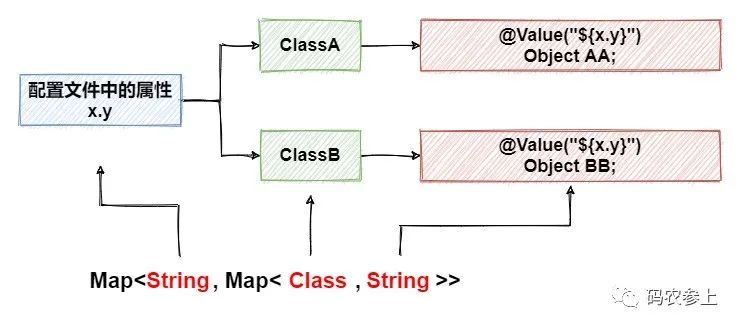
这里如果不好理解的话可以看看例子,我们引入两个测试Service:
@Service
public class UserService
@Value("$person.name")
String name;
@Value("$person.age")
Integer age;
@Service
public class UserDeptService
@Value("$person.name")
String pname;
在所有Class执行完add方法后,变量池pool中的数据是这样的:
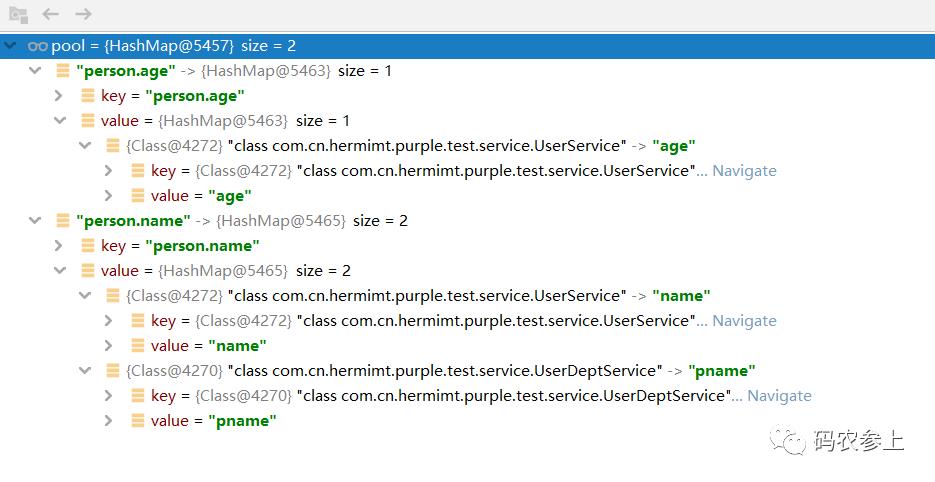
可以看到在pool中,person.name对应的内层Map中包含了两条数据,分别是UserService中的name字段,以及UserDeptService中的pname字段。
4、EnvInitializer
在VariablePool封装完所有变量数据后,ScanRunner会调用EnvInitializer的init方法,开始对yml文件进行解析,完成配置中心环境的初始化。其实说白了,这个环境就是一个静态的HashMap,key是属性名,value就是属性的值。
public class EnvInitializer
private static Map<String,Object> envMap=new HashMap<>();
public static void init()
String rootPath = EnvInitializer.class.getResource("/").getPath();
List<String> fileList = FileScanner.findFileByType(rootPath,null,FileScanner.TYPE_YML);
for (String ymlFilePath : fileList)
rootPath = FileScanner.getRealRootPath(rootPath);
ymlFilePath = ymlFilePath.replace(rootPath, "");
YamlMapFactoryBean yamlMapFb = new YamlMapFactoryBean();
yamlMapFb.setResources(new ClassPathResource(ymlFilePath));
Map<String, Object> map = yamlMapFb.getObject();
YamlConverter.doConvert(map,null,envMap);
public static void setEnvMap(Map<String, Object> envMap)
EnvInitializer.envMap = envMap;
public static Map<String, Object> getEnvMap()
return envMap;
首先还是使用FileScanner扫描根目录下所有的.yml结尾的文件,并使用spring自带的YamlMapFactoryBean进行yml文件的解析。但是这里有一个问题,所有yml文件解析后都会生成一个独立的Map,需要进行Map的合并,生成一份配置信息表。至于这一块具体的操作,都交给了下面的YamlConverter进行处理。
我们先进行一下演示,准备两个yml文件,配置文件一:application.yml
spring:
application:
name: hermit-purple
server:
port: 6879
person:
name: Hydra
age: 18配置文件二:config/test.yml
my:
name: John
friend:
name: Jay
sex: male
run: yeah先来看一看环境完成初始化后,生成的数据格式是这样的:
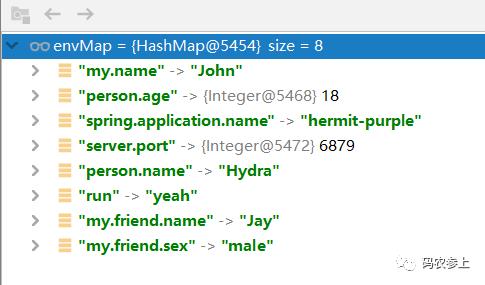
5、YamlConverter
YamlConverter主要实现的方法有三个:
doConvert():将EnvInitializer中提供的多个Map合并成一个单层MapmonoToMultiLayer():将单层Map转换为多层Map(为了生成yml格式字符串)convert():yml格式的字符串解析为Map(为了判断属性是否发生变化)
由于后面两个功能暂时还没有涉及,我们先看第一段代码:
public class YamlConverter
public static void doConvert(Map<String,Object> map,String parentKey,Map<String,Object> propertiesMap)
String prefix=(Objects.isNull(parentKey))?"":parentKey+".";
map.forEach((key,value)->
if (value instanceof Map)
doConvert((Map)value,prefix+key,propertiesMap);
else
propertiesMap.put(prefix+key,value);
);
//...
逻辑也很简单,通过循环遍历的方式,将多个Map最终都合并到了目的envMap中,并且如果遇到多层Map嵌套的情况,那么将多层Map的key通过点.进行了连接,最终得到了上面那张图中样式的单层Map。
其余两个方法,我们在下面使用到的场景再说。
6、ConfigController
ConfigController作为控制器,用于和前端进行交互,只有两个接口save和get,下面分别介绍。
get
前端页面在开启时会调用ConfigController中的get接口,填充到textArea中。先看一下get方法的实现:
@GetMapping("get")
public String get()
ObjectMapper objectMapper = new ObjectMapper(new YAMLFactory());
String yamlContent = null;
try
Map<String, Object> envMap = EnvInitializer.getEnvMap();
Map<String, Object> map = YamlConverter.monoToMultiLayer(envMap, null);
yamlContent = objectMapper.writeValueAsString(map);
catch (Exception e)
e.printStackTrace();
return yamlContent;
之前在项目启动时,就已经把配置文件属性封装到了EnvInitializer的envMap中,并且这个envMap是一个单层的Map,不存在嵌套关系。但是我们这里要使用jackson生成标准格式的yml文档,这种格式不符合要求,需要将它还原成一个具有层级关系的多层Map,就需要调用YamlConverter的monoToMultiLayer()方法。
monoToMultiLayer()方法的代码有点长,就不贴在这里了,主要是根据key中的.进行拆分并不断创建子级的Map,转换完成后得到的多层Map数据如下:
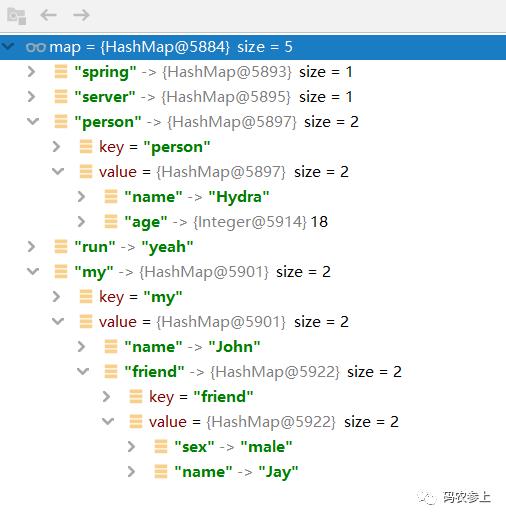
在获得这种格式后的Map后,就可以调用jackson中的方法将Map转换为yml格式的字符串传递给前端了,看一下处理完成后返回给前端的字符串:
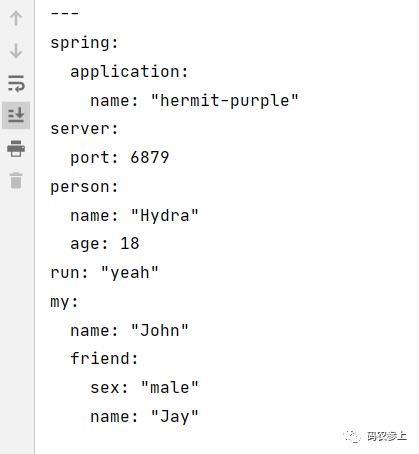
save
在前端页面修改了yml内容后点击保存时,会调用save方法保存并更新配置,方法的实现如下:
@PostMapping("save")
public String save(@RequestBody Map<String,Object> newValue)
String ymlContent =(String) newValue.get("yml");
PropertyTrigger.change(ymlContent);
return "success";
在拿到前端传过来的yml字符串后,调用PropertyTrigger的change方法,实现后续的更改逻辑。
7、PropertyTrigger
在调用change方法后,主要做的事情有两件:
修改
EnvInitializer中的环境envMap,用于前端页面刷新时返回新的数据,以及下一次属性改变时进行对比使用修改bean中属性的值,这也是整个配置中心最重要的功能
先看一下代码:
public class PropertyTrigger
public static void change(String ymlContent)
Map<String, Object> newMap = YamlConverter.convert(ymlContent);
Map<String, Object> oldMap = EnvInitializer.getEnvMap();
oldMap.keySet().stream()
.filter(key->newMap.containsKey(key))
.filter(key->!newMap.get(key).equals(oldMap.get(key)))
.forEach(key->
System.out.println(key);
Object newVal = newMap.get(key);
oldMap.put(key, newVal);
doChange(key,newVal);
);
EnvInitializer.setEnvMap(oldMap);
private static void doChange(String propertyName, Object newValue)
System.out.println("newValue:"+newValue);
Map<String, Map<Class, String>> pool = VariablePool.getPool();
Map<Class, String> classProMap = pool.get(propertyName);
classProMap.forEach((clazzName,realPropertyName)->
try
Object bean = SpringContextUtil.getBean(clazzName);
Field field = clazzName.getDeclaredField(realPropertyName);
field.setAccessible(true);
field.set(bean, newValue);
catch (NoSuchFieldException | IllegalAccessException e)
e.printStackTrace();
);
前面铺垫了那么多,其实就是为了实现这段代码中的功能,具体逻辑如下:
调用
YamlConverter的convert方法,将前端传来的yml格式字符串解析封装成单层Map,数据格式和EnvInitializer中的envMap相同遍历旧的
envMap,查看其中的key在新的Map中对应的属性值是否发生了改变,如果没有改变则不做之后的任何操作如果发生改变,用新的值替换
envMap中的旧值通过属性名称,从
VariablePool中拿到涉及改变的Class,以及类中的字段Field。并通过后面的SpringContextUtil中的方法获取到这个bean的实例对象,再通过反射改变字段的值将修改后的Map写回
EnvInitializer中的envMap
到这里,就实现了全部的功能。
8、SpringContextUtil
SpringContextUtil通过实现ApplicationContextAware接口获得了spring容器,而通过容器的getBean()方法就可以容易的拿到spring中的bean,方便进行后续的更改操作。
@Component
public class SpringContextUtil implements ApplicationContextAware
private static ApplicationContext applicationContext;
@Override
public void setApplicationContext(ApplicationContext applicationContext) throws BeansException
this.applicationContext = applicationContext;
public static <T> T getBean(Class<T> t)
return applicationContext.getBean(t);
9、前端代码
至于前端代码,就是一个非常简单的表单,代码的话可以移步git查看。
最后
到这里全部的代码介绍完了,最后做一个简要的总结吧,虽然通过这几个类能够实现一个简易版的配置中心功能,但是还有不少的缺陷,例如:
没有处理
@ConfigurationProperties注解只处理了yml文件,没有处理properties文件
目前处理的bean都是基于
singleton模式,如果作用域为prototype,也会存在问题反射性能低,如果某个属性涉及的类很多会影响性能
目前只能代码嵌入到项目中使用,还不支持独立部署及远程注册功能
……
总的来说,后续需要完善的点还有不少,真是感觉任重道远。
最后再聊聊项目的名称,为什么取名叫hermit-purple呢,来源是jojo中二乔的替身隐者之紫,感觉这个替身的能力和配置中心的感知功能还是蛮搭配的,所以就用了这个哈哈。
那么这次的分享就到这里,我是Hydra,预祝大家虎年春节快乐,我们下篇再见。
项目git地址:
https://github.com/trunks2008/hermit-purple-config
推荐

PS:因为公众号平台更改了推送规则,如果不想错过内容,记得读完点一下“在看”,加个“星标”,这样每次新文章推送才会第一时间出现在你的订阅列表里。点“在看”支持我们吧!
以上是关于硬核!8个类手写一个配置中心!的主要内容,如果未能解决你的问题,请参考以下文章
#yyds干货盘点#30个类手写Spring核心原理之AOP代码织入
#yyds干货盘点#30个类手写Spring核心原理之自定义ORM(上)